The paramilitary forces of China are the military units and formations apart from the People's Liberation Army, the principal military force of the People's Republic of China. They are composed of three main forces, the People's Liberation Army reserve force, the People's Armed Police (PAP), and the Militia, and they act as auxiliaries to the active forces of the People's Liberation Army. They generally perform a wide range of roles. All together, the paramilitary has 98,854,000 troops, as of 2018. [1]
The People's Armed Police Force [2] [lower-alpha 1] is a Chinese paramilitary organization [3] : 121 primarily responsible for internal security, riot control, counter-terrorism, disaster response, law enforcement and maritime rights protection [4] as well as providing support to the People's Liberation Army (PLA) during wartime. [5] : 87
Unlike the civilian People's Police, [lower-alpha 2] the PAP [lower-alpha 3] is a specialized paramilitary force reporting directly to the Central Military Commission (CMC). PAP officers and soldiers wear dark olive green uniforms, different from pine green uniforms of the People's Liberation Army Ground Force (PLAGF) or the light blue and black uniforms of the People's Police.The 1984 Military Service Law stipulated the combination of the militia and the reserve service system. Military training for senior middle-school and college and university students commenced in 1984 as China sought to provide additional qualified reserve service officers. The reserve force consisted primarily of the militia and was organized into reserve-service divisions and regiments.
In 1987 China began to make reference to the National Defense Reserve Force, which apparently consisted of reserve soldiers (including all militia, demobilized soldiers, and specialized technical personnel registered for reserve service) and reserve officers (including demobilized officers and soldiers assigned to reserve officer service, college and university graduates, and civilian officials and specialized technicians). The Reserve, as of 2016, is made up of 510,000 reserve personnel of all ranks.
The Xinjiang Production and Construction Corps (XJBT; 新疆生产建设兵团; 新疆兵团), also known as Bingtuan ("The Corps"), trading as the external name China Xinjian Group, [9] is a state-owned enterprise and paramilitary organization in China's Xinjiang Uyghur Autonomous Region.
The XJBT was established in 1954 under the orders of Mao Zedong, and developed sparsely populated areas in its early decades, taking the model of the traditional tuntian system of setting military units in frontier areas. The XJBT was severely damaged during the Cultural Revolution, and was outright abolished in 1975, before being re-established in 1981, partly due to the Soviet-Afghan War. It re-established its economic dominance over Xinjiang afterwards, also being responsible for maintenance against the "three evils" (separatism, religious extremism, and terrorism). In its history, the XJBT has built farms, towns, and cities, provided land and employment to disbanded military units, and re-settled Han migrants from other parts of China in what has been called a campaign of assimilation.
The People's Liberation Army (PLA) is the armed wing of the Chinese Communist Party (CCP) and the principal military force of the People's Republic of China. The PLA consists of four services — Ground Force, Navy, Air Force, and Rocket Force — and four arms — Aerospace Force, Cyberspace Force, Information Support Force, and Joint Logistics Support Force. It is led by the Central Military Commission (CMC) with its chairman as commander-in-chief.
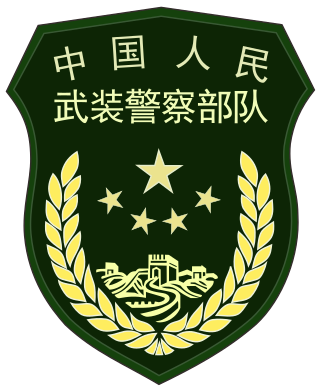
The People's Armed Police Force is a Chinese paramilitary organization primarily responsible for internal security, riot control, counter-terrorism, disaster response, law enforcement and maritime rights protection as well as providing support to the People's Liberation Army (PLA) during wartime.
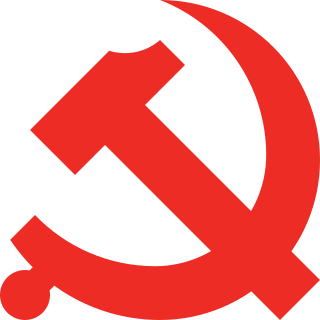
The Central Military Commission (CMC) is the highest national defense organization in the People's Republic of China, which heads the People's Liberation Army (PLA), the People's Armed Police (PAP), and the Militia of China.

Law enforcement in China consists of an extensive public security system and a variety of enforcement procedures used to maintain order in the country. Along with the courts and procuratorates, the country's judicial and public security agencies include the Ministry of Public Security (MPS) and the Ministry of State Security (MSS), with their descending hierarchy of departments, bureaus, subbureaus, and stations.
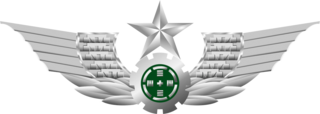
The People's Liberation Army Ground Force (PLAGF) is the land-based service branch of the People's Liberation Army (PLA), and also its largest and oldest branch. The PLAGF can trace its lineage from 1927 as the Chinese Red Army; however, it was not officially established until 1948.
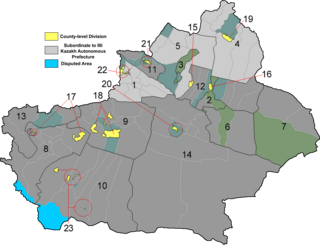
The Xinjiang Production and Construction Corps, also known as Bingtuan, trading as the external name China Xinjian Group, is a state-owned enterprise and paramilitary organization in China's Xinjiang Uyghur Autonomous Region.
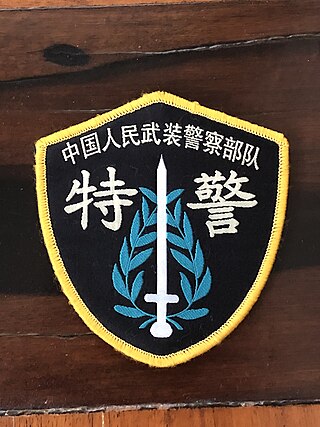
The Special Police Units are the police tactical units of the Chinese People's Armed Police (PAP) at the provincial and municipal levels. There is at least one of such unit in each Chinese province to offer their services when requested by the local police, or other law enforcement agencies such as the border police or railway patrol police and the people's police of the Ministry of Public Security (MPS).

Type 07 is a group of military uniforms used by all branches of the People's Liberation Army (PLA) of the People's Republic of China (PRC) and the paramilitary Chinese People's Armed Police Force. Introduced in 2007, the Type 07 uniforms replaced the Type 87 service uniforms used by regular units and the Type 97 Service Dress uniforms of the People's Liberation Army Hong Kong Garrison and the People's Liberation Army Macau Garrison. The Type 07 uniforms were first seen in late June 2007 during a celebration ceremony for the 10th anniversary of the Transfer of sovereignty over Hong Kong.

The Xinjiang Military District (新疆军区) is a special military area of the PLA at the Theater Deputy-grade.(副战区级). It is one of three districts that are directly under the Central Military Commission and its Joint Army Staff rather than under their Theater Command

The East Turkestan National Army was the armed forces of the Second East Turkestan Republic (ETR). It was active from 1945 to 1949, beyond the dissolution of the ETR in 1946, when it was renamed the Ili National Army per a peace agreement between the ETR leadership and representatives of the Republic of China. It originally consisted of six regiments: the Suidun Infantry Regiment, the Ghulja Regiment, the Kensai Regiment, the Ghulja Reserve Regiment, the Kazakh Cavalry Regiment, the Dungan Regiment, the Artillery Subdivision, the Sibo Subdivision, and the Mongol Subdivision. The last two subdivisions were later reformed to regiments. All regiments were armed with mostly German-made weapons that were provided by the Soviet Union on orders by Joseph Stalin. Its personnel was trained in the Soviet Union. Rebel aviation included 42 airplanes, which were captured in the Ghulja Kuomintang air base and repaired by Soviet military personnel.
The national security of China is the coordination of a variety of organizations, including law enforcement, military, paramilitary, governmental, and intelligence agencies that aim to ensure China's national security. China considers three factors in its national security: national sovereignty, security, and development interests.
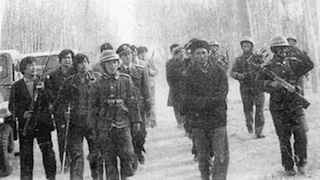
The Barin uprising was an armed conflict between Uyghur militants and Chinese government forces from 4 to 10 April 1990 in the township of Barin in Xinjiang, China. Violence began on the evening of 4 April, when a group of 200 to 300 Uyghur men attempted to breach the gates of the local government office in a protest against alleged forced abortions of Uyghur women and Chinese rule in Xinjiang. The arrival of 130 armed police to quell the unrest was immediately met with armed resistance by militants among the crowd. Initial clashes that evening left six policemen dead and 13 wounded. The militants also captured five policemen, while the armed police captured 19 militants.

The Militia or Militia of China is the militia part of the armed forces of China, the other two parts being the People's Liberation Army (PLA) and the People's Armed Police (PAP). The Militia is under the leadership of the Chinese Communist Party (CCP) and serves as an auxiliary and reserve force for the PLA. It is one of the largest militias in the world.

The 50th anniversary of the founding of the People's Republic of China took place on 1 October 1999. A military parade was held in Tiananmen Square in Beijing and various celebrations were conducted all over the country. China's paramount leader Jiang Zemin inspected the troops along Chang'an Avenue in Beijing. This parade was immediately followed by a civilian parade.
The 35th anniversary of the founding of the People's Republic of China took place on 1 October 1984. A military parade was held in Tiananmen Square in Beijing and various celebrations were conducted all over the country. China's paramount leader Deng Xiaoping inspected the troops along Chang'an Avenue in Beijing. This parade was immediately followed by a civilian parade.

The People's Police is the national civilian police force of the People's Republic of China. Police in China have a variety of roles in addition to enforcing the law, they are also responsible for the maintenance of social stability, and in this sense policing in China performs not just a law enforcement function but a political function as well. The majority of national police forces are under the jurisdiction of the Ministry of Public Security (MPS).

The National Day Parade, officially the National Day of the People's Republic of China Parade, is a civil-military parade event held at Tiananmen Square in Beijing, the capital of the People's Republic of China, on the National Day of the People's Republic of China on 1 October. It is organized by the People's Liberation Army, the People's Armed Police and the Militia, as well as civilian groups of the Chinese Communist Party (CCP). It has been held every decade since 1959, annually from 1950 to 1959, and has been broadcast live on China Central Television since 1984.
The Reserve Infantry Division of Xinjiang Military District(Chinese: 新疆军区陆军预备役步兵师) is a reserve infantry formation of the People's Liberation Army.
Yang Fulin is a former Chinese military officer and politician who served as deputy commander of Xinjiang Production and Construction Corps from 2015 to 2017. He was investigated by China's top anti-graft agency in July 2021.
Peng Jingtang is a major general in the People's Liberation Army who is the current commander of the PLA Hong Kong Garrison, in office since January 2022.